Tarbosaurus
Tarbosaurus (/ˌtɑːrbəˈsɔːrəs/ TAR-bə-SAWR-əs; meaning "alarming lizard") is a genus of tyrannosaurid theropod dinosaur that flourished in Asia about 70 million years ago, at the end of the Late Cretaceous Period, considered to contain a single known species, Tarbosaurus bataar. Fossils have been recovered in Mongolia, with more fragmentary remains found further afield in parts of China.
| Tarbosaurus | |
|---|---|
 | |
| Skeleton on exhibit in Dinosaurium, Prague | |
| Scientific classification | |
| Kingdom: | Animalia |
| Phylum: | Chordata |
| Clade: | Dinosauria |
| Clade: | Saurischia |
| Clade: | Theropoda |
| Clade: | †Eutyrannosauria |
| Family: | †Tyrannosauridae |
| Subfamily: | †Tyrannosaurinae |
| Genus: | †Tarbosaurus Maleev, 1955 |
| Species: | †T. bataar |
| Binomial name | |
| †Tarbosaurus bataar (Maleev, 1955) [originally Tyrannosaurus] | |
| Synonyms | |
|
Genus synonymy
Species synonymy
| |
Although many species have been named, modern paleontologists recognize only one, T. bataar, as valid. Some experts see this species as an Asian representative of the North American genus Tyrannosaurus; this would make the genus Tarbosaurus redundant. Tarbosaurus and Tyrannosaurus, if not synonymous, are considered to be at least closely related genera. Alioramus, also from Mongolia, has previously been thought by some authorities to be the closest relative of Tarbosaurus, though this has since been disproven with the discovery of Qianzhousaurus and the description of the Alioramini.
Like most known tyrannosaurids, Tarbosaurus was a large bipedal predator, weighing up to five tonnes and equipped with about sixty large teeth. It had a unique locking mechanism in its lower jaw and the smallest forelimbs relative to body size of all tyrannosaurids, renowned for their disproportionately tiny, two-fingered forelimbs.
Tarbosaurus lived in a humid floodplain criss-crossed by river channels. In this environment, it was an apex predator, probably preying on other large dinosaurs like the hadrosaur Saurolophus or the sauropod Nemegtosaurus. Tarbosaurus is represented by dozens of fossil specimens, including several complete skulls and skeletons. These remains have allowed scientific studies focusing on its phylogeny, skull mechanics, and brain structure.
Discovery and naming

In 1946, a joint Soviet-Mongolian expedition to the Gobi Desert in the Mongolian Ömnögovi Province turned up a large theropod skull and some vertebrae in the Nemegt Formation. In 1955, Evgeny Maleev, a Soviet paleontologist, made this specimen the holotype (PIN 551-1) of a new species, which he called Tyrannosaurus bataar.[2] The specific name is a misspelling of the Mongolian баатар/baatar ("hero").[3] In the same year, Maleev also described and named three new theropod skulls, each associated with skeletal remains discovered by the same expedition in 1948 and 1949. The first of these (PIN 551-2) was named Tarbosaurus efremovi, a new generic name composed of the Ancient Greek τάρβος (tarbos) ("terror", "alarm", "awe", or "reverence") and σαυρος (sauros) ("lizard"),[4] and the species named after Ivan Yefremov, a Russian paleontologist and science fiction author. The other two (PIN 553-1 and PIN 552-2) were also named as new species and assigned to the North American genus Gorgosaurus (G. lancinator and G. novojilovi, respectively). All three of these latter specimens are smaller than the first.[5]

A 1965 paper by A.K. Rozhdestvensky recognized all of Maleev's specimens as different growth stages of the same species, which he believed to be distinct from the North American Tyrannosaurus. He created a new combination, Tarbosaurus bataar, to include all the specimens described in 1955 as well as newer material.[6] Later authors, including Maleev himself,[7] agreed with Rozhdestvensky's analysis, although some used the name Tarbosaurus efremovi rather than T. bataar.[8] American paleontologist Kenneth Carpenter re-examined the material in 1992. He concluded that it belonged to the genus Tyrannosaurus, as originally published by Maleev, and lumped all the specimens into the species Tyrannosaurus bataar except the remains that Maleev had named Gorgosaurus novojilovi. Carpenter thought this specimen represented a separate, smaller genus of tyrannosaurid, which he called Maleevosaurus novojilovi.[9] George Olshevsky created the new generic name Jenghizkhan (after Genghis Khan) for Tyrannosaurus bataar in 1995, while also recognizing Tarbosaurus efremovi and Maleevosaurus novojilovi, for a total of three distinct, contemporaneous genera from the Nemegt Formation.[10] A 1999 study subsequently reclassified Maleevosaurus as a juvenile Tarbosaurus.[11] All research published since 1999 recognizes only a single species, which is either called Tarbosaurus bataar[12][13][14] or Tyrannosaurus bataar.[15]
After the original Russian-Mongolian expeditions in the 1940s, Polish-Mongolian joint expeditions to the Gobi Desert began in 1963 and continued until 1971, recovering many new fossils, including new specimens of Tarbosaurus from the Nemegt Formation.[3] Expeditions involving Japanese and Mongolian scientists between 1993 and 1998,[16] as well as private expeditions hosted by Canadian paleontologist Phil Currie around the turn of the 21st century, discovered and collected further Tarbosaurus material.[17][18] More than 30 specimens are known, including more than 15 skulls and several complete postcranial skeletons.[12]
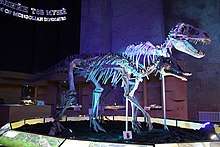
Tarbosaurus fossils are only found around the Gobi Desert of Mongolia and China, both of which ban their export, though some specimens have been looted by private collectors.[19] A recent $1 million smuggling deal was uncovered when suspicions were raised about a catalog put out by Heritage Auctions for an event in New York City on May 20, 2012. By Mongolian law, any specimen found in the Gobi Desert was to rest at an appropriate Mongolian institution and there was little reasonable doubt that the Tarbosaurus bataar advertised on the catalog was a stolen one. The president of Mongolia and many paleontologists raised objections to the sale which led to a last-minute investigation that confirmed that it was a specimen that can only be found in the Gobi Desert, rightfully belonging to Mongolia.[20] During the court case (United States v. One Tyrannosaurus Bataar Skeleton), Eric Prokopi, the smuggler, pleaded guilty to illegal smuggling and the dinosaur was returned to Mongolia in 2013, where it is temporarily displayed on Sukhbaatar Square, the center of the city of Ulaanbaatar.[21] Prokopi had sold the dinosaur with a partner and fellow commercial hunter in England, Christopher Moore.[22] The case led to the repatriation of dozens more Mongolian dinosaurs, including several skeletons of Tarbosaurus bataar.[23]
Synonyms

Chinese paleontologists discovered a partial skull and skeleton of a small theropod (IVPP V4878) in the Xinjiang Autonomous Region of China in the mid-1960s. In 1977, Dong Zhiming described this specimen, which was recovered from the Subashi Formation in Shanshan County, as a new genus and species, Shanshanosaurus huoyanshanensis.[24] Gregory Paul recognized Shanshanosaurus as a tyrannosaurid in 1988, referring it to the now-defunct genus Aublysodon.[25] Dong and Currie later re-examined the specimen and deemed it to be a juvenile of a larger species of tyrannosaurid. These authors refrained from assigning it to any particular genus but suggested Tarbosaurus as a possibility.[26]
Albertosaurus periculosus, Tyrannosaurus luanchuanensis, Tyrannosaurus turpanensis and Chingkankousaurus fragilis were considered synonyms of Tarbosaurus in the second edition of the Dinosauria, but Chingkankousaurus has been assessed as dubious by Brusatte et al. (2013).[12][27]
Named in 1976 by Sergei Kurzanov, Alioramus is another genus of tyrannosaurid from slightly older sediments in Mongolia.[28] Several analyses have concluded Alioramus was quite closely related to Tarbosaurus.[3][13] It was described as an adult, but its long, low skull is characteristic of a juvenile tyrannosaurid. This led Currie to speculate that Alioramus might represent a juvenile Tarbosaurus, but he noted that the much higher tooth count and row of crests on top of the snout suggested otherwise.[29]
Description

Although slightly smaller than Tyrannosaurus, Tarbosaurus was one of the largest tyrannosaurids. The largest known individuals were between 10 and 12 m (33 and 39 ft) long.[5] The mass of a fully grown individual is considered comparable to or slightly smaller than Tyrannosaurus, often estimated to be around 4–5 metric tons.[30][31]
The largest known Tarbosaurus skull is more than 1.3 m (4.3 ft) long, larger than all other tyrannosaurids except Tyrannosaurus.[12] The skull was tall, like that of Tyrannosaurus, but not as wide, especially towards the rear. The unexpanded rear of the skull meant that Tarbosaurus eyes did not face directly forwards, suggesting that it lacked the binocular vision of Tyrannosaurus. Large fenestrae (openings) in the skull reduced its weight. Between 58 and 64 teeth lined its jaws, slightly more than in Tyrannosaurus but fewer than in smaller tyrannosaurids like Gorgosaurus and Alioramus. Most of its teeth were oval in cross section, although the teeth of the premaxilla at the tip of the upper jaw had a D-shaped cross section. This heterodonty is characteristic of the family. The longest teeth were in the maxilla (upper jaw bone), with crowns up to 85 millimeters (3.3 in) long. In the lower jaw, a ridge on the outer surface of the angular bone articulated with the rear of the dentary bone, creating a locking mechanism unique to Tarbosaurus and Alioramus. Other tyrannosaurids lacked this ridge and had more flexibility in the lower jaw.[3]
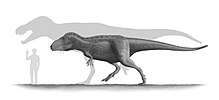
Tyrannosaurids varied little in body form, and Tarbosaurus was no exception. The head was supported by an S-shaped neck, while the rest of the vertebral column, including the long tail, was held horizontally. Tarbosaurus had tiny forelimbs, proportionably to body size the smallest of all members of the family. The hands had two clawed digits each, with an additional unclawed third metacarpal found in some specimens, similar to closely related genera. Holtz has suggested that Tarbosaurus also has a theropod reduction of fingers IV-I "developed further" than in other tyrannosaurids,[32] as the second metacarpal in the Tarbosaurus specimens he studied is less than twice the length of the first metacarpal (other tyrannosaurids have a second metacarpal about twice the length of the first metacarpal). Also, the third metacarpal in Tarbosaurus is proportionally shorter than in other tyrannosaurids; in other tyrannosaurids (like Albertosaurus and Daspletosaurus), the third metacarpal is often longer than the first metacarpal, while in the Tarbosaurus specimens studied by Holtz, the third metacarpal is shorter than the first.[12]
In contrast to the forelimbs, the three-toed hindlimbs were long and thick, supporting the body in a bipedal posture. The long, heavy tail served as a counterweight to the head and torso and placed the center of gravity over the hips.[5][12]
Classification

Tarbosaurus is classified as a theropod in the subfamily Tyrannosaurinae within the family Tyrannosauridae. Other members include Tyrannosaurus and the earlier Daspletosaurus, both from North America,[15] and possibly the Mongolian genus Alioramus.[3][13] Animals in this subfamily are more closely related to Tyrannosaurus than to Albertosaurus and are known for their robust build with proportionally larger skulls and longer femurs than in the other subfamily, the Albertosaurinae.[12]
Tarbosaurus bataar was originally described as a species of Tyrannosaurus,[2] an arrangement that has been supported by some more recent studies.[15][9] Others prefer to keep the genera separate, while still recognizing them as sister taxa.[12] A 2003 cladistic analysis based on skull features instead identified Alioramus as the closest known relative of Tarbosaurus, as the two genera share skull characteristics that are related to stress distribution and that are not found in other tyrannosaurines. If proven, this relationship would argue against Tarbosaurus becoming a synonym for Tyrannosaurus and would suggest that separate tyrannosaurine lineages evolved in Asia and North America.[3][13] The two known specimens of Alioramus, which show juvenile characteristics, are not likely juvenile individuals of Tarbosaurus because of their much higher tooth count (76 to 78 teeth) and their unique row of bony bumps along the top of their snouts.[29]
The discovery of Lythronax argestes, a much earlier tyrannosaurine further reveals the close relationship between Tyrannosaurus and Tarbosaurus, and it was discovered that Lythronax is a sister taxon to a clade consisting of Campanian genus Zhuchengtyrannus, and Maastrichtian genera Tyrannosaurus and Tarbosaurus. Further studies of Lythronax also suggest that the Asian tyrannosauroids were part of one evolutionary radiation.[33]

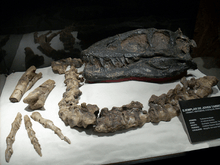
Below is the cladogram of Tyrannosauridae based on the phylogenetic analysis conducted by Loewen et al. in 2013.[34]
| Tyrannosauridae |
| ||||||||||||||||||||||||||||||||||||||||||||||||||||||||||||
Paleobiology
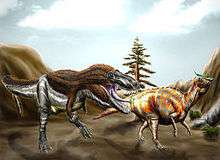
Like several other large tyrannosaurids, Tarbosaurus is known from relatively abundant and well-preserved fossil material. In fact, one-quarter of all fossils collected from the Nemegt Formation belong to Tarbosaurus.[35] Although Tarbosaurus has not been studied as thoroughly as the North American tyrannosaurids,[3] the available material has allowed scientists to draw limited conclusions about its biology.
In 2001, Bruce Rothschild and others published a study examining evidence for stress fractures and tendon avulsions in theropod dinosaurs and the implications for their behavior. Since stress fractures are caused by repeated trauma rather than singular events they are more likely to be caused by regular behavior than other types of injuries. None of the eighteen Tarbosaurus foot bones examined in the study was found to have a stress fracture, but one of the ten examined hand bones was found to have one. Stress fractures in the hands have special behavioral significance compared to those found in the feet since stress fractures there can be obtained while running or during migration. Hand injuries, by contrast, are more likely to be obtained while in contact with struggling prey. The presence of stress fractures and tendon avulsions, in general, provide evidence for a "very active" predation-based diet rather than obligate scavenging.[36]
In 2012, bite marks on two fragmentary gastralia of the holotype specimen of the large ornithomimosaur Deinocheirus mirificus were reported. The size and shape of the bite marks match the teeth of Tarbosaurus, the largest known predator from the Nemegt Formation. Various types of feeding traces were identified; punctures, gouges, striae, fragmentary teeth, and combinations of the above marks. The bite marks probably represent feeding behavior instead of aggression between the species, and the fact that bite marks were not found elsewhere on the body indicates the predator focused on internal organs. Tarbosaurus bite marks have also been identified on hadrosaur and sauropod fossils, but theropod bite marks on bones of other theropods are very rare in the fossil record.[37]
Skull mechanics
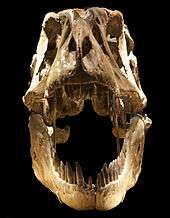
The skull of Tarbosaurus was completely described for the first time in 2003. Scientists noted key differences between Tarbosaurus and the North American tyrannosaurids. Many of these differences are related to the handling of stress by the skull bones during a bite. When the upper jaw bit down on an object, force was transmitted up through the maxilla, the primary tooth-bearing bone of the upper jaw, into surrounding skull bones. In North American tyrannosaurids, this force went from the maxilla into the fused nasal bones on top of the snout, which were firmly connected in the rear to the lacrimal bones by bony struts. These struts locked the two bones together, suggesting that force was then transmitted from the nasals to the lacrimals.[3]
Tarbosaurus lacked these bony struts, and the connection between the nasals and lacrimals was weak. Instead, a backwards projection of the maxilla was massively developed in Tarbosaurus and fit inside a sheath formed from the lacrimal. This projection was a thin, bony plate in North American tyrannosaurids. The large backwards projection suggests that force was transmitted more directly from the maxilla to the lacrimal in Tarbosaurus. The lacrimal was also more firmly anchored to the frontal and prefrontal bones in Tarbosaurus. The well-developed connections between the maxilla, lacrimal, frontal and prefrontal would have made its entire upper jaw more rigid.[3]
Another major difference between Tarbosaurus and its North American relatives was its more rigid mandible (lower jaw). While many theropods, including North American tyrannosaurids, had some degree of flexibility between the bones in the rear of the mandible and the dentary in the front, Tarbosaurus had a locking mechanism formed from a ridge on the surface of the angular, which articulated with a square process on the rear of the dentary.[3]
Some scientists have hypothesized that the more rigid skull of Tarbosaurus was an adaptation to hunting the massive titanosaurid sauropods found in the Nemegt Formation, which did not exist in most of North America during the Late Cretaceous. The differences in skull mechanics also affect tyrannosaurid phylogeny. Tarbosaurus-like articulations between the skull bones are also seen in Alioramus from Mongolia, suggesting that it, and not Tyrannosaurus, is the closest relative of Tarbosaurus. Similarities between Tarbosaurus and Tyrannosaurus might, therefore, be related to their large size, independently developed through convergent evolution.[3]
Bite force and feeding habits
There is evidence to suggest that Tarbosaurus was both a predator and scavenger, as seen with its fossilized bite marks being found on Saurolophus remains.[38] As for its bite force, it was revealed that Tarbosaurus had a bite force of around 8,000 to 10,000 pounds per force, meaning that it could possibly crush bone like its North American relative, Tyrannosaurus.[39]
Brain structure

A Tarbosaurus skull found in 1948 by Soviet and Mongolian scientists (PIN 553-1, originally called Gorgosaurus lancinator) included the skull cavity that held the brain. Making a plaster cast, called an endocast, of the inside of this cavity allowed Maleev to make preliminary observations about the shape of a Tarbosaurus brain.[40] A newer polyurethane rubber cast allowed a more detailed study of Tarbosaurus brain structure and function.[41]
The endocranial structure of Tarbosaurus was similar to that of Tyrannosaurus,[42] differing only in the positions of some cranial nerve roots, including the trigeminal and accessory nerves. Tyrannosaurid brains were more similar to those of crocodilians and other nonavian reptiles than to birds. The total brain volume for a 12 metres (39 ft) Tarbosaurus is estimated at only 184 cubic centimetres (11.2 cu in).[41]
The large size of the olfactory bulbs, as well as the terminal and olfactory nerves, suggest that Tarbosaurus had a keen sense of smell, as was also the case with Tyrannosaurus. The vomeronasal bulb is large and differentiated from the olfactory bulb, which was initially suggested as being indicative of a well-developed Jacobsen's organ, which was used to detect pheromones. This may imply that Tarbosaurus had complex mating behavior.[41] However, the identification of the vomeronasal bulb has been challenged by other researchers, since they are not present in any living archosaurs.[43]
The auditory nerve was also large, suggesting good hearing, which may have been useful for auditory communication and spatial awareness. The nerve had a well-developed vestibular component as well, which implies a good sense of balance and coordination. In contrast, the nerves and brain structures associated with eyesight were smaller and undeveloped. The midbrain tectum, responsible for visual processing in reptiles, was very small in Tarbosaurus, as were the optic nerve and the oculomotor nerve, which controls eye movement. Unlike Tyrannosaurus, which had forward-facing eyes that provided some degree of binocular vision, Tarbosaurus had a narrower skull more typical of other tyrannosaurids in which the eyes faced primarily sideways. All of this suggests that Tarbosaurus relied more on its senses of smell and hearing than on its eyesight.[41]
Life history
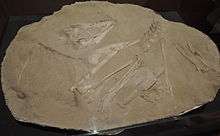
Most specimens of Tarbosaurus represent adult or subadult individuals; juveniles remain very rare. Nevertheless, the 2006 discovery of a juvenile skeleton including a complete, 290-millimetre (0.95 ft) long skull provides information on the life history of this dinosaur. This individual probably was aged 2 to 3 years at the time of death. Compared with adult skulls, the juvenile skull was weakly constructed and the teeth were thin, indicating different food preferences in juveniles and adults that reduced competition between different age groups.[44] Examination of the sclerotic rings in this juvenile Tarbosaurus suggests they may also have been crepuscular or nocturnal hunters. Whether the adult Tarbosaurus were also nocturnal is currently unknown due to lack of fossil evidence.[45]
Skin impressions and footprints
Skin impressions were recovered from a large skeleton at the Bugiin Tsav locality that was previously destroyed by poachers. These impressions show non-overlapping scales with an average diameter of 2.4 millimetres (0.094 in) and pertain to the thoracic region of the individual, although the exact position can not be assessed any longer due to the destruction of the skeleton.[46]
Phil Currie and colleagues (2003) described two footprints from the Nemegt locality that probably pertain to Tarbosaurus. These tracks represent natural casts, which means that only the sandy infill of the tracks and not the tracks itself are preserved. The better-preserved tracks feature skin impressions over large areas on and behind the toe impressions that are similar to those discovered in Bugiin Tsav. They also feature vertical parallel slide marks that were left by scales when the foot was pushed into the ground. The track measures 61 centimeters (24 in) in length, thus representing a large individual. The second track, although even larger, was affected by erosion and does not show any detail.[46]
Paleoecology
The vast majority of known Tarbosaurus fossils were recovered from the Nemegt Formation in the Gobi Desert of southern Mongolia. This geologic formation has never been dated radiometrically, but the fauna present in the fossil record indicate it was probably deposited during the early Maastrichtian stage, at the end of the Late Cretaceous[35] about 70 million years ago.[47][48] The Subashi Formation, in which Shanshanosaurus remains were discovered, is also Maastrichtian in age.[49]
Tarbosaurus is found chiefly in the Nemegt Formation, whose sediments preserve large river channels and soil deposits that indicate a far more humid climate than those suggested by the underlying Barun Goyot and Djadochta Formations. However, caliche deposits indicate at least periodic droughts. Sediment was deposited in the channels and floodplains of large rivers. The rock facies of this formation suggest the presence of mudflats, and shallow lakes. Sediments also indicate that there existed a rich habitat, offering diverse food in abundant amounts that could sustain massive Cretaceous dinosaurs.[50] Fossils of an unidentified tyrannosaur from the older Djadochta Formation, which closely resemble those of Tarbosaurus, may indicate that it also lived at an earlier time and in a more arid ecosystem than that of the Nemegt.[1]

Occasional mollusk fossils are found, as well as a variety of other aquatic animals like fish and turtles.[35] Crocodilians included several species of Shamosuchus, a genus with teeth adapted for crushing shells.[51] Mammal fossils are exceedingly rare in the Nemegt Formation, but many birds have been found, including the enantiornithine Gurilynia and the hesperornithiform Judinornis, as well as Teviornis, an early representative of the still-existing Anseriformes (waterfowl). Scientists have described many dinosaurs from the Nemegt Formation, including the ankylosaurid Saichania, and pachycephalosaur Prenocephale.[35] By far the largest predator known from the formation, adult Tarbosaurus most likely preyed upon large hadrosaurs such as Saurolophus and Barsboldia, or sauropods such as Nemegtosaurus, and Opisthocoelicaudia.[3] Adults would have received little competition from small theropods such as the small tyrannosaurid Alioramus, troodontids (Borogovia, Tochisaurus, Zanabazar), oviraptorosaurs (Elmisaurus, Nemegtomaia, Rinchenia) or Bagaraatan, sometimes considered a basal tyrannosauroid. Other theropods, like the gigantic Therizinosaurus, might have been herbivorous, and ornithomimosaurs such as Anserimimus, Gallimimus, and gigantic Deinocheirus might have been omnivores that only took small prey and were therefore no competition for Tarbosaurus. However, as in other large tyrannosaurids as well as modern Komodo dragons, juveniles and subadult Tarbosaurus would have filled niches between the massive adults and these smaller theropods.[12]
See also
References
- Mortimer, M (2004). "Tyrannosauroidea". The Theropod Database. Archived from the original on 2013-09-29. Retrieved 2007-08-21.
- Maleev, Evgeny A. (1955). "Giant carnivorous dinosaurs of Mongolia". Doklady Akademii Nauk SSSR. 104 (4): 634–637.
- Hurum, Jørn H.; Sabath, Karol (2003). "Giant theropod dinosaurs from Asia and North America: Skulls of Tarbosaurus bataar and Tyrannosaurus rex compared" (PDF). Acta Palaeontologica Polonica. 48 (2): 161–190.
- Liddell, Henry G.; Scott, Robert (1980). Greek–English Lexicon (Abridged ed.). Oxford: Oxford University Press. ISBN 978-0-19-910207-5.
- Maleev, E. A. (1955). translated by F. J. Alcock. "New carnivorous dinosaurs from the Upper Cretaceous of Mongolia" (PDF). Doklady Akademii Nauk SSSR. 104 (5): 779–783.
- Rozhdestvensky, Anatoly K. (1965). "Growth changes in Asian dinosaurs and some problems of their taxonomy". Paleontological Journal. 3: 95–109.
- Maleev, Evgeny A. (1974). "Gigantic carnosaurs of the family Tyrannosauridae". The Joint Soviet-Mongolian Paleontological Expedition Transactions. 1: 132–191.
- Barsbold, Rinchen (1983). "Carnivorous dinosaurs from the Cretaceous of Mongolia". The Joint Soviet-Mongolian Paleontological Expedition Transactions. 19: 5–119.
- Carpenter, Ken. (1992). "Tyrannosaurids (Dinosauria) of Asia and North America". In Mateer, Niall J.; Peiji, Chen (eds.). Aspects of Nonmarine Cretaceous Geology. Beijing: China Ocean Press. pp. 250–268.
- Olshevsky, George; Ford, Tracy L. (1995). "The origin and evolution of the tyrannosaurids, part 1". Dinosaur Frontline (in Japanese). 9: 92–119.
- Carr, Thomas D. (1999). "Craniofacial ontogeny in Tyrannosauridae (Dinosauria, Coelurosauria)". Journal of Vertebrate Paleontology. 19 (3): 497–520. doi:10.1080/02724634.1999.10011161.
- Holtz, Thomas R., Jr. (2004). "Tyrannosauroidea". In Weishampel, David B.; Dodson, Peter; Osmólska, Halszka (eds.). The Dinosauria (Second ed.). Berkeley: University of California Press. p. 124. ISBN 978-0-520-24209-8.
- Currie, Philip J.; Hurum, Jørn H.; Sabath, Karol (2003). "Skull structure and evolution in tyrannosaurid phylogeny" (PDF). Acta Palaeontologica Polonica. 48 (2): 227–234.
- Xu Xing; Norell, Mark A.; Kuang Xuewen; Wang Xiaolin; Zhao Qi; Jia Chengkai (2004). "Basal tyrannosauroids from China and evidence for protofeathers in tyrannosauroids". Nature. 431 (7009): 680–684. Bibcode:2004Natur.431..680X. doi:10.1038/nature02855. PMID 15470426.
- Carr, Thomas D.; Williamson, Thomas E.; Schwimmer, David R. (2005). "A new genus and species of tyrannosauroid from the Late Cretaceous (middle Campanian) Demopolis Formation of Alabama". Journal of Vertebrate Paleontology. 25 (1): 119–143. doi:10.1671/0272-4634(2005)025[0119:ANGASO]2.0.CO;2.
- Watabe, Masato; Suzuki, Shigeru (2000). "Cretaceous fossil localities and a list of fossils collected by the Hayashibara Museum of Natural Sciences and Mongolian Paleontological Center Joint Paleontological Expedition (JMJPE) from 1993 through 1998". Hayashibara Museum of Natural Sciences Research Bulletin. 1: 99–108.
- Currie, Philip J. (2001). "Nomadic Expeditions, Inc., report of fieldwork in Mongolia, September 2000.". Alberta Palaeontological Society, Fifth Annual Symposium, Abstract Volume. Calgary: Mount Royal College. pp. 12–16.
- Currie, Philip J. (2002). "Report on fieldwork in Mongolia, September 2001.". Alberta Palaeontological Society, Sixth Annual Symposium, 'Fossils 2002,' Abstract Volume. Calgary: Mount Royal College. pp. 8–12.
- Switek, Brian (19 May 2012). "Stop the Tarbosaurus Auction!". Wired.
- Switek, Brian. "The Million Dollar Dinosaur Scandal". Slate.com. Retrieved 21 August 2013.
- Parry, Wynne (May 7, 2013). "Mongolia gets stolen dinosaur back". Mother Nature Network. Retrieved 21 August 2013.
- Williams, Paige (January 28, 2013). "Bones of Contention". The New Yorker. Retrieved 2017-09-09.
- Williams, Paige (June 7, 2014). "The Black Market for Dinosaurs". The New Yorker. Retrieved 2017-09-09.
- Dong Zhiming (1977). "On the dinosaurian remains from Turpan, Xinjiang". Vertebrata PalAsiatica (in Chinese). 15: 59–66.
- Paul, Gregory S. (1988). Predatory Dinosaurs of the World. New York: Simon & Schuster. p. 464.
- Currie, Philip J.; Dong Zhiming (2001). "New information on Shanshanosaurus huoyanshanensis, a juvenile tyrannosaurid (Theropoda, Dinosauria) from the Late Cretaceous of China". Canadian Journal of Earth Sciences. 38 (12): 1729–1737. Bibcode:2001CaJES..38.1729C. doi:10.1139/cjes-38-12-1729.
- Brusatte, Hone and Xu, 2013. Phylogenetic revision of Chingkankousaurus fragilis, a forgotten tyrannosauroid from the Late Cretaceous of China. in Parrish, Molnar, Currie and Koppelhus (eds.). Tyrannosaurid Paleobiology. Indiana University Press. 1-13.
- Kurzanov, Sergei M. (1976). "A new Late Cretaceous carnosaur from Nogon−Tsav, Mongolia". The Joint Soviet-Mongolian Paleontological Expedition Transactions (in Russian). 3: 93–104.
- Currie, Philip J. (2003). "Cranial anatomy of tyrannosaurids from the Late Cretaceous of Alberta" (PDF). Acta Palaeontologica Polonica. 48 (2): 191–226. Archived from the original (PDF) on 2007-06-21.
- Paul, G.S., 2010, The Princeton Field Guide to Dinosaurs, Princeton University Press.
- Valkenburgh, B.; Molnar, R. E. (2002). "Dinosaurian and mammalian predators compared". Paleobiology. 28 (4): 527–543. doi:10.1666/0094-8373(2002)028<0527:DAMPC>2.0.CO;2. ISSN 0094-8373.
- Carpenter K, Tanke D.H. & Skrepnick M.W. (2001), Mesozoic Vertebrate Life (Indiana University Press, ISBN 0-253-33907-3), p. 71.
- Loewen, Mark A; Irmis, Randall B; Sertich, Joseph J. W; Currie, Philip J; Sampson, Scott D (2013-11-06). "Tyrant Dinosaur Evolution Tracks the Rise and Fall of Late Cretaceous Oceans". PLOS ONE. 8 (11): e79420. Bibcode:2013PLoSO...879420L. doi:10.1371/journal.pone.0079420. PMC 3819173. PMID 24223179.
- Loewen, M. A.; Irmis, R. B.; Sertich, J. J. W.; Currie, P. J.; Sampson, S. D. (2013). Evans, David C. (ed.). "Tyrant Dinosaur Evolution Tracks the Rise and Fall of Late Cretaceous Oceans". PLoS ONE. 8 (11): e79420. Bibcode:2013PLoSO...879420L. doi:10.1371/journal.pone.0079420. PMC 3819173. PMID 24223179.
- Jerzykiewicz, Tomasz; Russell, Dale A. (1991). "Late Mesozoic stratigraphy and vertebrates of the Gobi Basin". Cretaceous Research. 12 (4): 345–377. doi:10.1016/0195-6671(91)90015-5.
- Rothschild, B., Tanke, D. H., and Ford, T. L., 2001, Theropod stress fractures and tendon avulsions as a clue to activity: In: Mesozoic Vertebrate Life, edited by Tanke, D. H., and Carpenter, K., Indiana University Press, p. 331-336.
- Bell, P. R.; Currie, P. J.; Lee, Y. N. (2012). "Tyrannosaur feeding traces on Deinocheirus (Theropoda:?Ornithomimosauria) remains from the Nemegt Formation (Late Cretaceous), Mongolia". Cretaceous Research. 37: 186–190. doi:10.1016/j.cretres.2012.03.018.
- Switek, Brian. "Tarbosaurus: A Predator and a Scavenger With a Delicate Bite". Smithsonian Magazine. doi:10.4202/app.2009.0133. Retrieved 11 November 2018.
- Therrien, Francois; Henderson, Donald M.; Ruff, Christopher B. (January 2005). "Bite me: Biomechanical models of theropod mandibles and implications for feeding behavior". In Kenneth Carpenter (ed.). The Carnivorous Dinosaurs. Indiana University Press. pp. 179–237. Retrieved 11 November 2018.
- Maleev, Evgeny A. (1965). "On the brain of carnivorous dinosaurs". Paleontological Journal (in Russian). 2: 141–143.
- Saveliev, Sergei V.; Alifanov, Vladimir R. (2005). "A new study of the brain of the predatory dinosaur Tarbosaurus bataar (Theropoda, Tyrannosauridae)". Paleontological Journal. 41 (3): 281–289. doi:10.1134/S0031030107030070.
- Brochu, Christopher A. (2000). "A digitally-rendered endocast for Tyrannosaurus rex". Journal of Vertebrate Paleontology. 20 (1): 1–6. doi:10.1671/0272-4634(2000)020[0001:ADREFT]2.0.CO;2.
- Bever, G.S.; Brusatte, S.L.; Carr, T.D.; Xu, X.; Balanoff, A.M.; Norell, M.A. (2013). "The Braincase Anatomy of the Late Cretaceous Dinosaur Alioramus (Theropoda: Tyrannosauroidea)". Bulletin of the American Museum of Natural History. 376: 1–72. doi:10.1206/810.1. hdl:2246/6422.
- Tsuihiji, Takanobu; Watabe, Mahito; Tsogtbaatar, Khishigjav; Tsubamoto, Takehisa; Barsbold, Rinchen; Suzuki, Shigeru; Lee, Andrew H.; Ridgely, Ryan C.; Kawahara, Yasuhiro; Witmer, Lawrence M. (2011-05-01). "Cranial Osteology of a Juvenile Specimen of Tarbosaurus bataar (Theropoda, Tyrannosauridae) from the Nemegt Formation (Upper Cretaceous) of Bugin Tsav, Mongolia". Journal of Vertebrate Paleontology. 31 (3): 497–517. doi:10.1080/02724634.2011.557116.
- Tsuihiji, Takanobu; Watabe, Mahito; Tsogtbaatar, Khishigjav; Tsubamoto, Takehisa; Barsbold, Rinchen; Suzuki, Shigeru; Lee, Andrew H; Ridgely, Ryan C; Kawahara, Yasuhiro; Witmer, Lawrence M (2011-05-16). "Tiny Tarbosaurus Shows How Tyrants Grew Up | Science | Smithsonian". Journal of Vertebrate Paleontology. 31 (3): 497–517. doi:10.1080/02724634.2011.557116. Retrieved 2017-06-06.
- Currie, Philip J.; Badamgarav, Demchig; Koppelhus, Eva B. (2003). "The First Late Cretaceous Footprints from the Locality in the Gobi of Mongolia". Ichnos. 10: 1–12. doi:10.1080/10420940390235071.
- Sulliban, R.M. (2006). "A taxonomic review of the Pachycephalosauridae (Dinosauria: Ornithischia)." Pp. 347-366 in Lucas, S.G. and Sullivan, R.M. (eds.), Late Cretaceous vertebrates from the Western Interior. New Mexico Museum of Natural History and Science Bulletin 3.
- Gradstein, Felix M.; Ogg, James G.; and Smith, Alan G. (2005). A Geologic Time Scale 2004. Cambridge: Cambridge University Press. pp. 500pp. ISBN 978-0-521-78142-8.
- Shen, Y.B.; Mateer, Niall J. (1992). "An outline of the Cretaceous System in northern Xinjiang, western China". In Mateer, Niall J.; Peiji, Chen (eds.). Aspects of Nonmarine Cretaceous Geology. Beijing: China Ocean Press. pp. 49–77.
- Novacek, M. (1996). Dinosaurs of the Flaming Cliffs. Bantam Doubleday Dell Publishing Group Inc. New York, New York. ISBN 978-0-385-47775-8
- Efimov, Mikhail B. (1983). "Revision of the fossil crocodiles of Mongolia". The Joint Soviet-Mongolian Paleontological Expedition Transactions (in Russian). 24: 76–95.
External links
| Wikispecies has information related to Tarbosaurus |
| Wikimedia Commons has media related to Tarbosaurus. |
Images and photos
- Skeletal image of Shanshanosaurus at The Grave Yard.
- Comparison between Tarbosaurus skulls from specimens of different age group and size.
Readable material
- Discussion and specimen list at The Theropod Database.
- Review of the Tyrannosauridae by George Olshevsky (1995).
- Scienceblogs: Juvenile, 5 years old Tarbosaurus specimen found in Mongolia 2006.

















